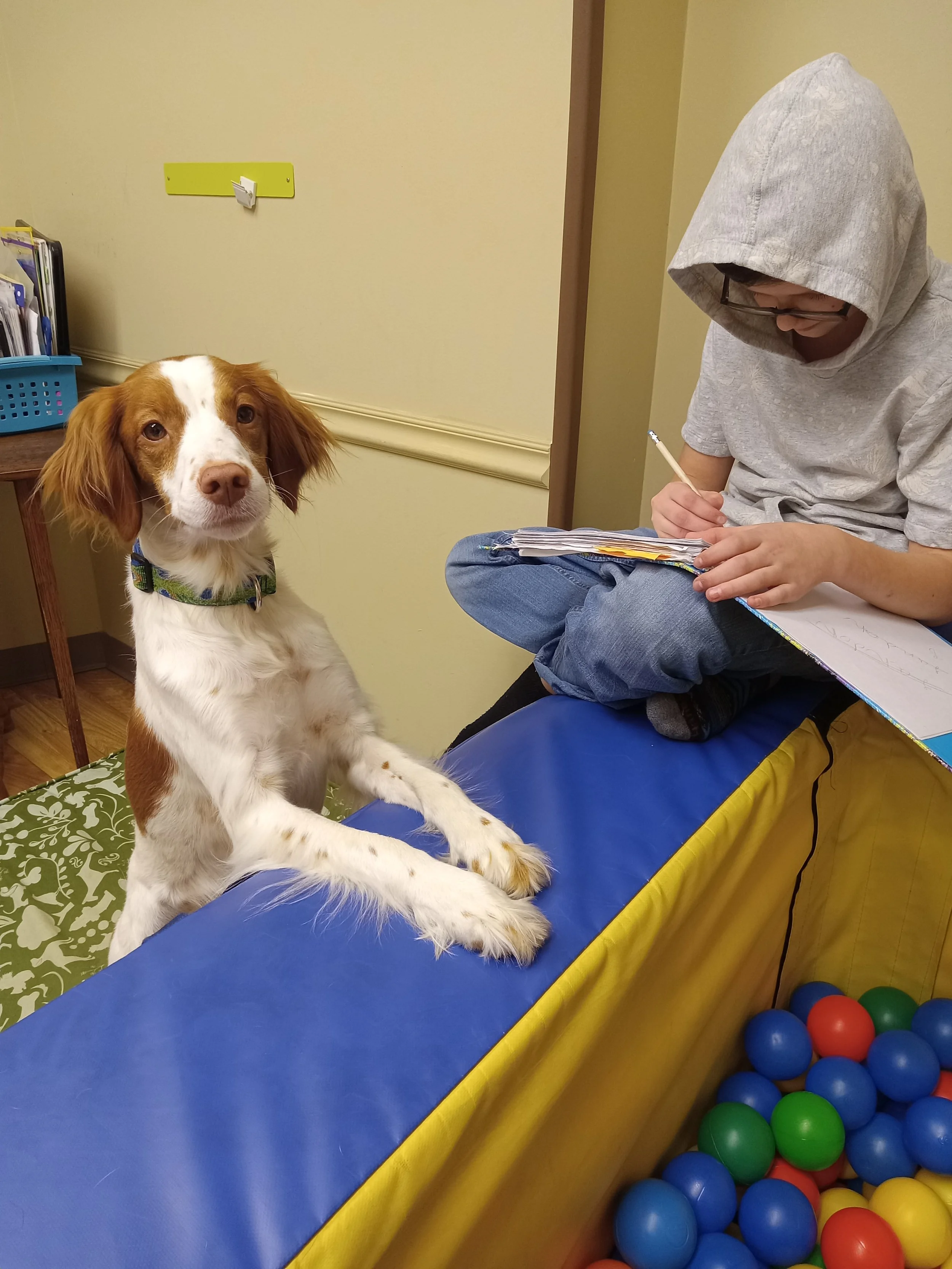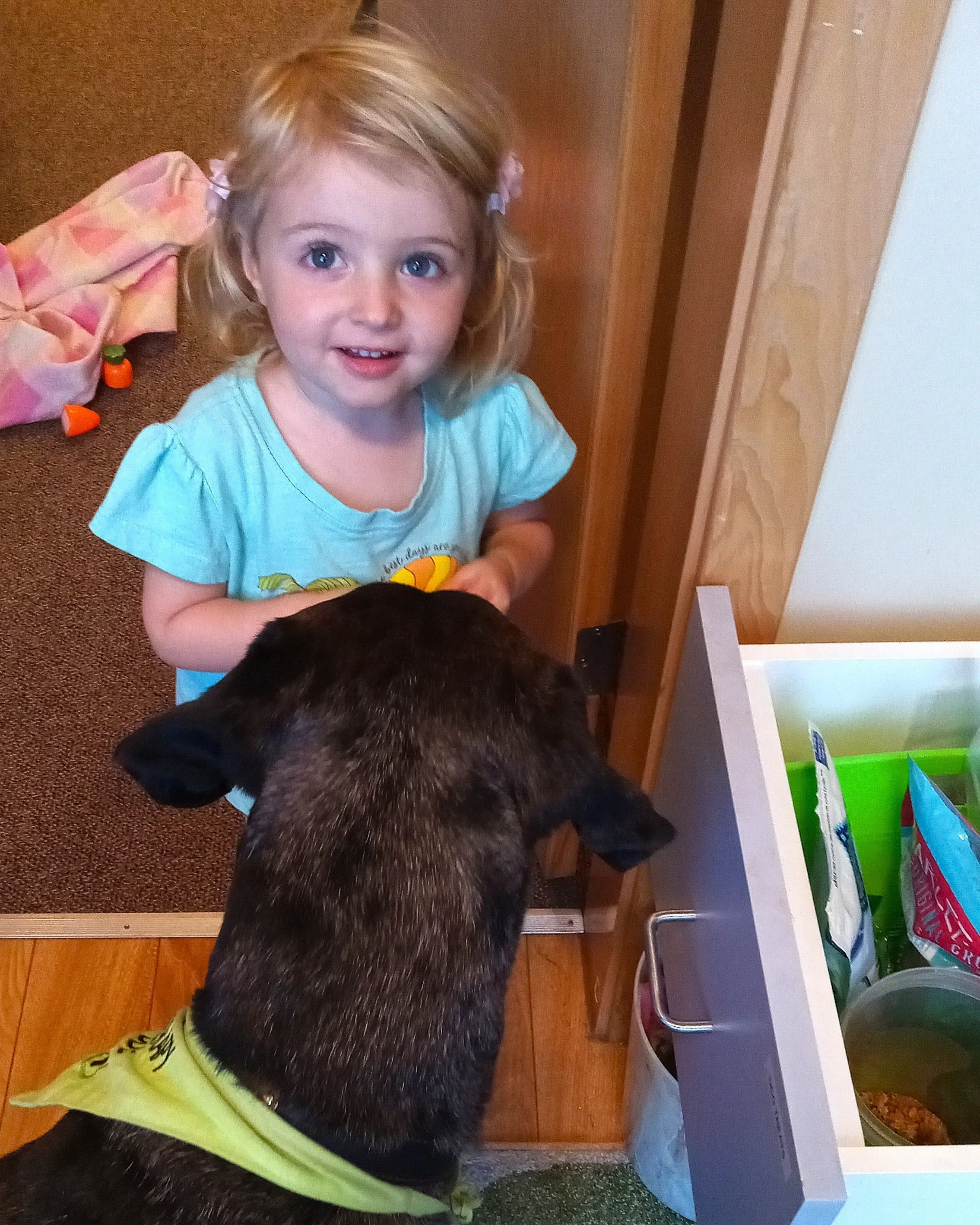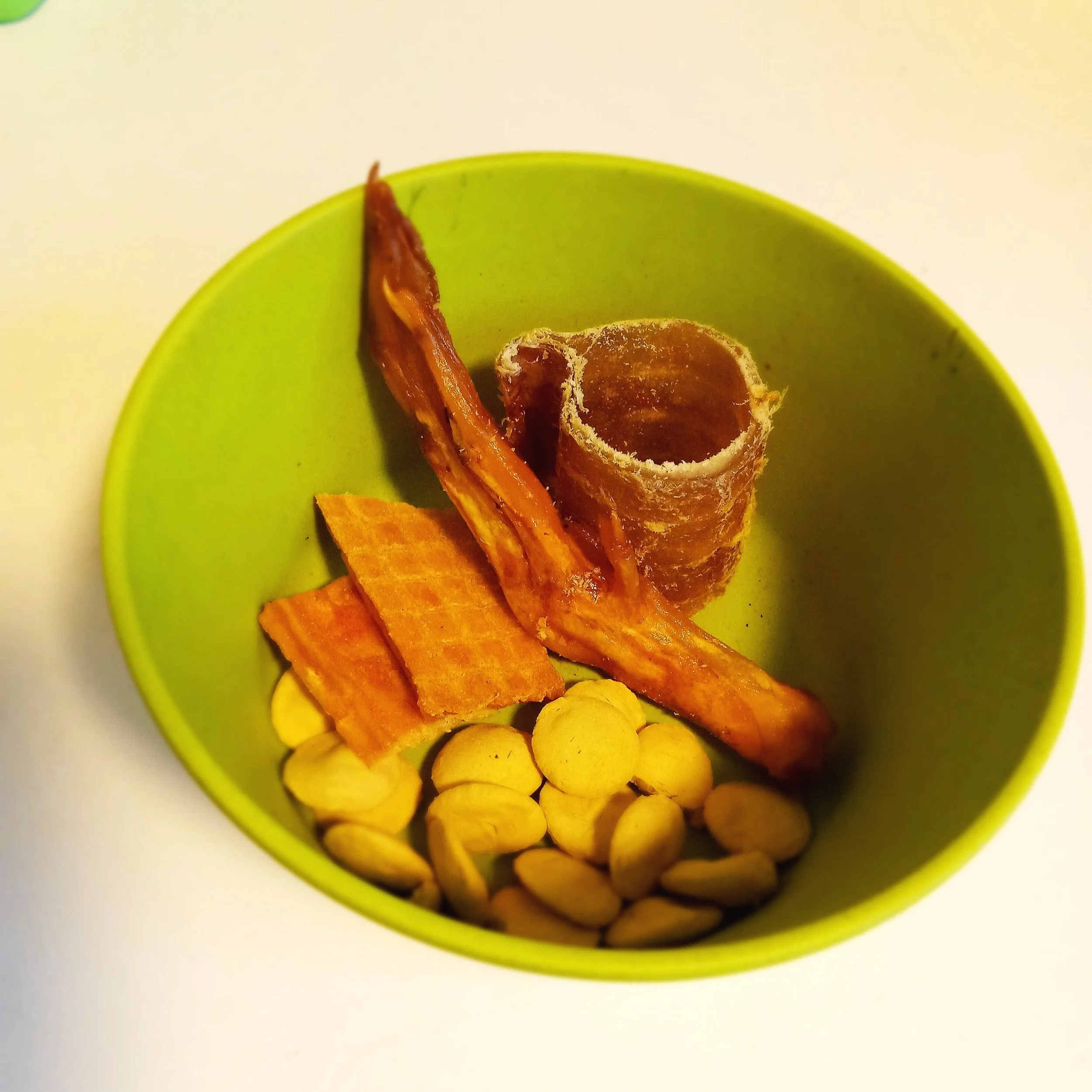Why Becoming a Speech Therapy Dog-Handler Team is Simple…But NOT Easy!
“Simple doesn’t mean easy.”
It’s a platitude I’ve heard many times in many contexts.
A platitude I’ve largely ignored until this week, when my passion to combine the power of therapy dogs with my chosen field of Speech-Language Pathology seemed to hit stumbling block after stumbling block. I happened to be listening to a completely unrelated audiobook on my drive home from work when I heard the line again and I literally had to pull over to write it down.
Simple. Doesn’t. Mean. Easy.
Huh. Those four words exactly encompassed the emotional roller-coaster I’ve been on this week. Situations in which I know exactly what steps need to be taken, and yet, actually accomplishing the task is eluding me.
Here’s what I’m facing as I write this (but read all the way to the postscript for updates!)...
New speech therapy dog Sky enjoys supporting a child during animal-assisted speech therapy.
If you click a link, it’s likely an affiliate link and I will earn a small commission if you purchase. It doesn’t cost you anything extra. If I don’t use and love a product, you won’t find it here!
Challenge #1: Training a new speech therapy dog recruit
As I type this, Sky, the precious little Brittany I’m preparing for the Canine Good Citizen test, just can’t keep “four on the floor” when it’s time to greet people.
All she has to do is sit momentarily while a stranger pets her. Heck, she can stand or lie down for all I care. And she can do that…sometimes…sort-of; usually after a few repetitions and the novelty of the task has died down.
You can watch the wheels turning in her brain. She clearly knows the expectation, but then…her butt starts to wiggle and like a wave the wiggle travels up her body until she just can’t hold it in anymore and she pops up for split second (sometimes with a quick kiss if the person is bending over) before slamming herself back to the ground.
Frustrating, because I want--no need—her to pass the CGC before I can even consider our next steps toward therapy dog work.
Frustrating, because gosh darn it I’ve trained many dogs, attended countless hours of obedience and agility classes, and read more books on dog training than I can count (for some of my favorites, see Animal-Assisted Therapy Books and DVDs here.)
Frustrating because my brain naturally wants to anthropomorphize Sky and say “She’s could do it if she just tried harder.”
But when I forced myself to stop and really reflect on the situation, here’s what I discovered:
· Sky has come a really, really long way in just a few months. She’s never had any real boundaries placed on her in the past, and now she is (mostly) walking on a loose leash, staying focused in sit and down-stays, checking in with me as I move around the room during training sessions, and performing several new tricks. I have to give credit where credit is due.
· Sky’s affiliative nature is high, and that’s exactly what I want for the work I hope she will participate in. We can improve the impulse-control with time and training, but it’s much harder to teach a dog to love interacting with strangers.
· Sky is learning at her own pace and I can’t impose my desire to rush the process onto her. While I’ve set goals in my mind for when we meet certain signposts on our speech therapy dog journey, the reality is that she will get there when it’s time for her to get there.
So I just need to remember these points as we continue to train and socialize.
Simple, right?!? But easy? No.
Therapy dog Delta typically remains calmly nearby during animal-assisted speech therapy, but lately has been more excitable around young clients.
Challenge #2: Reviewing a previously mastered skill with an experienced speech therapy dog
Delta has come to work with me for nearly five years now (see my journey to animal-assisted speech therapy). We had some struggles at first, but with a team of trainer, behaviorist, and holistic veterinarian, in addition to lots of research on my part, she has blossomed into a steady partner who accepts her many roles at the office with grace.
However…I’ve recently added several new toddlers and preschoolers to my caseload that require a pretty high degree of excitement and movement to stay engaged, and Delta has responded by becoming excitable herself.
It’s nice to see her have so much vivacity, but she’s a big dog and could knock the little ones down.
She also is getting pushy about wanting to interact with them instead of waiting on her bed until the time is right as she does with slightly older kids.
When I close her in my inner office, where her extra-comfy bed is, she has started whining as soon as she finishes her “long-lasting” chew. (Side note: anyone with a strong chewer knows that “long-lasting” means about five minutes.)
All she has to do is take a rest until I come get her.
Simple, right? After all, she’s usually great at taking naps throughout the day to conserve energy.
So I just need to…find a better treat to keep her distracted longer? Take the time to review separation training? Work with her to desensitize to the gasps, jumps and excited voice I use to gain these kids’ attention? All of the above?
Simple, right?!? But easy? No. (Read to the end for an update on this training challenge.)
I’ve had to be flexible when incorporating Delta into sessions with my younger clients, as she can become excitable in response to their higher energy level.
Here she accepts a treat from a toddler before being asked to wait on her bed for a portion of our animal-assisted speech therapy session.
Challenge #3: The self-reflection process of studying for the C-AAAIS test for animal-assisted interventionists
After months of contemplation, I took the plunge and applied to become an Animal-Assisted Intervention Specialist through AAAIP, an organization pioneering education and standardization for health and human service professionals incorporating therapy animals into their practice.
Though it’s a young organization, I’ve been consistently impressed with their offerings. And reading through the candidate handbook I knew there were definitely some areas I could improve my knowledge to better serve my clients and help other SLPs interested in partnering with a speech therapy dog.
So I just needed to study and take the test. I was a straight-A student, I’m good at studying. Should be simple enough.
Except AAAIP doesn’t tell you where to find the information, just what topics you need to know. While most of the requirements were already in my wheelhouse, there were some I simply couldn’t find answers to.
Not in their courses.
Not in the Handbook on Animal-Assisted Interventions.
Not even on Google.
But even more than that, I found I wasn’t always comfortable with their recommended policies, some of which are clearly geared towards minimizing liability to an extreme degree.
I found myself questioning, am I a terrible person because I let the kids feed my therapy dogs treats? (They recommend using a bowl or spoon to deliver treats or having clients glove up to avoid contact with saliva which has a very slight potential to transmit disease, even though they clearly state this has never actually been reported in an animal-assisted intervention).
Or because I’ve used leash corrections when training my speech therapy dogs, even if the vast majority of the time I’m using relationship-based, positive training methodology?
And a big one, I had never considered the dehydrated treats I feed my therapy dogs as high-value rewards and to support joint health are considered raw-food and therefore not appropriate due to the slight risk they could carry salmonella.
After considerable reflections my personal answers to these situations are:
· The joy and motivation my kids express at getting to feed treats, not to mention the spontaneous language that happens around the occasional slobber, is worth spending the extra time hand-washing. I have added asking if there is anyone at the home that is immunocompromised to my initial intake and take that into consideration in how I incorporate dogs into a session if needed.
· I will continue to strive to learn more about dog-training to use positive methods, while recognizing that no-one is perfect and I’ve done the best I can with the information I’ve been provided in the past.
· I have never fed raw food for meals, though I do make my own stews for a portion of the dogs’ diets. Having lived with a dog crippled by arthritis, though, I can’t imagine removing the nutrients found in some of the natural dog treats my therapy dogs love so much. But, there’s no reason they can’t be baked in the oven when I receive them to further reduce the slight risk they harbor pathogens. And I’ll remain diligent about the hand-washing procedures in my office while giving caregivers the choice of if they wish their child to feed treats given the potential risks.
(Your responses may be different. Take the time to decide what is right for you and your canine partner within the realm of reasonable adherence to professional guidelines.)
A sample of the treats, large and small, that I incorporate into our animal-assisted speech therapy sessions.
Some of these require extra precautions, but I personally find the health benefits for my therapy dogs worth the trouble.
So I just need to study for a test.
Simple, right?!? But easy? No.
As you proceed along your journey toward providing animal-assisted speech therapy, whether you’re reading this blog as your first introduction to the topic or are a seasoned pro, remember that being a great speech therapy dog-handler team is simple.
All you have to do is have solid clinical skills in your field, have a reasonably well-trained animal that remains reasonably calm throughout the day, and find innovative ways to improve client outcomes through the dog’s presence.
Simple, right?!? But easy? No.
Are you interested in learning more about how to safely and effectively incorporate a speech therapy dog to meet client goals? Please follow @Speech_Dogs on Instagram and check out the resources elsewhere on this site to learn more.
Stay tuned for updates on how you can get a copy of my comprehensive book on the topic, Paws for Progress: Integrating Animal-Assisted Interventions Into Your Speech-Language Pathology Practice, coming from ASHA Press September ‘24.
May your days be filled with puppy wiggles and children’s giggles,
Sharlet
P.S., It’s been a few months since I originally typed this post...
Our obedience trainer showed me a great trick to help Sky stay down during greeting, rubbing an acupressure point on her ear to both calm and slightly distract her as people approach and it works! Most of the time…
I started giving Delta Kongs stuffed with sunflower seed butter when she needs to stay in my inner office alone and took the time to practice outside of an actual session to review calm separations. I also remembered I had Dog Appeasing Phermone on hand and started spritzing some on a corner of her bed periodically throughout the day.
And I took the Certified Animal-Assisted Intervention Specialist test…and passed!
Related Articles:





